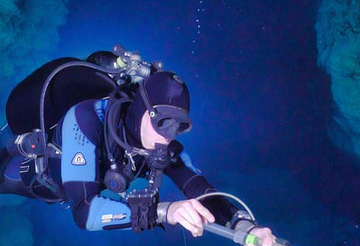
Cave Diving In the Bahamas (Training Required)
Share
Are you planning a trip to the breathtaking Caribbean to do some serious cave diving? If so, you’re in for an awesome treat! The Bahamas has a reputation for being one of the most popular destinations for cave diving. Locals brag about the ocean caves that are teeming with marine life. The virgin offshore reefs are home to an abundance of lobsters, crabs, shrimp and sponges. The largest island in the Bahamas is Andros. It is the third largest barrier reef in the world. Andros provides an exciting and challenging opportunity to cave dive in sensational blue holes. The incredible underwater wrecks, famous movie sets and unbelievable ocean life is enough to lure any diver. But true cave divers have an even better incentive. They come to explore the underwater vertical wall that has a drop of 6000 feet. Needless to say, this objective is not for the faint at heart!
As any experienced caver already realizes, cave diving is an extremely specialized activity. Trained cavers know that there are some very specific rules that contribute to a cave divers safety. This is true of cavers who seriously dive for sport and speleologists who explore caves for scientific study. Whether for sport or for science, serious cave divers recognize the importance of knowledge and training. That is why the anxious beginner who sets off prematurely is frowned upon. Amateurs sometimes get away with spelunking (amateur diving) when they are cavern diving, but their lack of knowledge and training can lead to serious harm if they attempt cave diving.
Although precautions are also necessary when cavern diving, the circumstances are not as difficult as they are with cave diving. With cave diving, the depth and interior of the caves offer more of a challenge. This is especially so when cave diving in the Bahamas. Individuals not trained in cave diving should not allow visions of unique flora and fauna to entice them to go beyond their diving limitations. No matter how beautiful a cave’s architecture is due to the stalactites and stalagmites that have formed, it still poses a danger to the untrained diver.
Some cavers who have been cavern diving for a while may feel they know enough to unofficially advance to cave diving. This is a huge and potentially dangerous mistake. Cavern divers are not accustomed to diving beyond the outermost part of the cave. The caves they typically explore can still be reached by natural light. With cave diving, visibility may be low to non-existent. The underwater caves in the Bahamas are complex. The many tunnels with their inflowing and out flowing currents can be tricky and potentially dangerous to an unskilled cave diver. Statistics indicate that the majority of diver fatalities result from divers who failed to undergo specialized training or who failed to have the proper equipment for the diving environment.
A 1977 publication by cave diver Sheck Exley discussed common causes of cave diving accidents. Basic Cave Diving: A Blueprint for Survival has since become the cave diver’s Bible. The techniques that resulted from that blueprint are now referred to as Accident Analysis. If you will be exploring caves in the Bahamas, you probably have taken cave diving courses that include Accident Analysis. Learning the five most recognized cave diving rules is essential.
Cave diving is considered to be a technical form of diving because it requires the use of specialized SCUBA gear. Due to the potentially high risk, the need for the proper skills and equipment should not be taken lightly. This form of penetration diving does not allow the diver to ascend directly to the surface in an emergency. For obvious reasons, the diver would have to swim horizontally to avoid the cave’s ceiling. Navigating through the cave and maintaining sufficient breathing gas could pose a potential problem if a diver is not properly prepared. In spite of the risks, natural and artificial caves that are partially filled with water continue to attract cavers.
The Bahamas provide a welcome environment to divers of all levels. Individuals come from everywhere to experience the warm blue holes and underwater caves that nature has abundantly decorated. Those seeking to advance their training can attend The Bahamas Underground. It is the only technical and cave diving oriented training and adventure facility in the Bahamas. It can be found in Marsh Harbor, Abaco, Bahamas. The Bahamas Underground provides training and guide services to the most fantastic blue holes and underwater caves the Bahamas have to offer.
